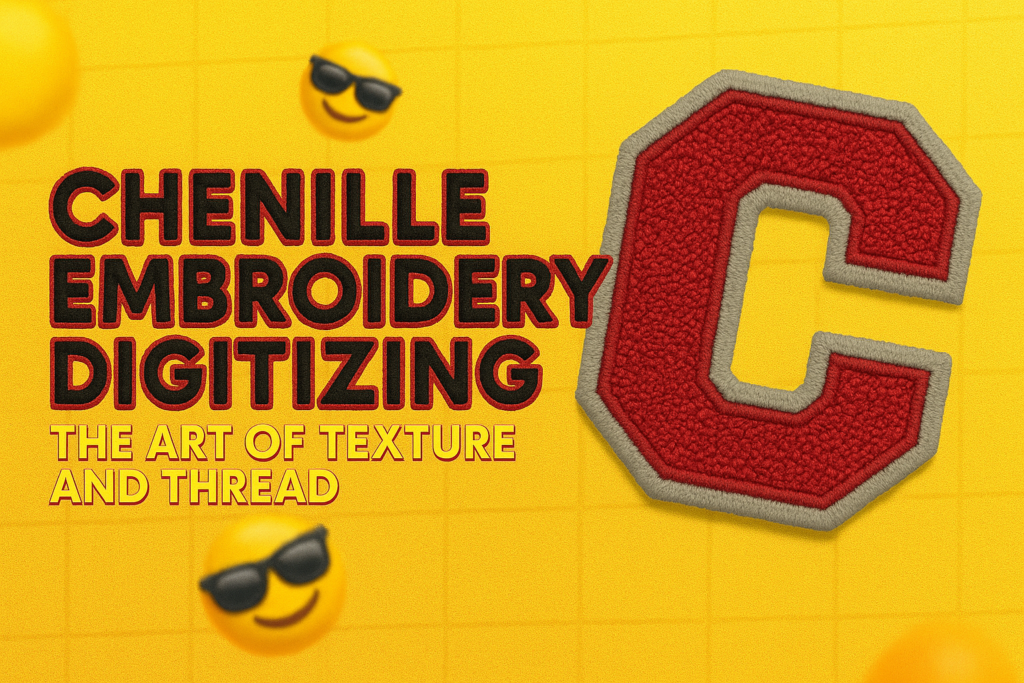Among the many embroidery techniques that have stood the test of time, few are as eye-catching and tactile as chenille embroidery. Known for its plush, velvety loops and retro aesthetic, chenille embroidery offers a texture-rich alternative to flat stitching—one that brings warmth, character, and a handcrafted feel to garments and accessories.
From the varsity jackets of mid-century America to modern luxury streetwear, chenille has evolved while staying true to its soft, bold roots. It’s a technique that speaks not just to the eye, but to the fingertips—inviting people to feel the design, not just look at it.
In this post, we’ll explore the world of chenille embroidery: where it came from, how it’s done, and why it continues to captivate designers, artisans, and wearers alike.
A Quick Look Back: The Origins of Chenille
The word chenille comes from the French word for “caterpillar,” a fitting description for the fuzzy texture that defines the style. Though chenille fabric has existed for centuries, chenille embroidery emerged more prominently in the 19th and 20th centuries, particularly as part of the textile and fashion industries in Europe and the United States.
The technique gained popularity in American high schools and colleges during the 1950s, where chenille patches—often shaped into letters, numbers, or mascots—were proudly displayed on letterman jackets and varsity sweaters. These emblems weren’t just decorative; they were symbols of school pride, achievement, and identity.
But chenille didn’t stay confined to school sportswear. Over time, it found its way into military apparel, promotional items, home décor, and fashion. Its rich texture, vintage appeal, and versatility have kept it relevant through shifting trends and evolving technology.
What Is Chenille Embroidery?
Unlike traditional embroidery, which uses smooth satin or fill stitches to create flat designs, chenille embroidery relies on looped or chain stitches to create a raised, fluffy surface. The result is a design that stands out—literally.
Chenille embroidery is often done using specialized machines equipped with chenille attachments. These machines create looped stitches with thick threads like wool, acrylic, or cotton yarn, which form a piled, velvety finish similar to that of a rug or a tufted fabric.
Designs made with chenille are not only more tactile but also visually dynamic. The play of light on the raised surfaces gives depth and softness, making them popular for bold lettering, logos, patches, and statement pieces.
The Process Behind Chenille Embroidery
Creating a chenille design involves more than just stitching thread into fabric. It requires precise planning, thoughtful material choices, and a specialized stitching technique.
Here’s a simplified look at how chenille embroidery comes together:
1. The Design Phase
Before any stitching begins, the design is drawn out—either by hand or digitally. This includes deciding which areas will be done in chenille versus flat embroidery, what type of thread will be used, and how dense the loops should be.
Chenille designs often feature large, bold letters or icons because the technique works best on simple shapes that allow the texture to shine.
2. Preparing the Fabric
A stable base fabric is key. Chenille embroidery requires a material that can handle the weight and density of the thick threads without stretching or puckering. Common base fabrics include felt, wool, cotton twill, or even leather for heavy-duty applications.
Backing materials like felt or stabilizers are also used to support the design and prevent distortion over time.
3. Stitching the Loops
The magic of chenille happens in the stitching. With the help of a chenille embroidery machine, loop stitches are formed by pushing thick thread through the fabric, then catching it in a chain stitch underneath. This forms small loops on the surface, which are either left intact or sheared for a softer, uniform texture.
Stitch height, loop density, and stitch direction are carefully adjusted to ensure the loops are even, aligned, and aesthetically pleasing.
4. Final Finishing
After the embroidery is complete, excess backing fabric is trimmed, and the design is cleaned and brushed to enhance the plush texture. For iron-on patches, a heat-activated adhesive backing is applied. For direct-to-garment embroidery, the piece may be steamed or pressed to smooth the final look.
The Art of Texture: Why Chenille Embroidery Feels So Unique
What makes chenille stand out is its sensory appeal. It’s not just visual—it’s touchable. Unlike traditional embroidery that can sometimes feel stiff or sharp to the skin, chenille has a comforting softness. This makes it ideal for pieces that invite physical interaction—jackets, sweatshirts, pillows, caps, and blankets.
Design-wise, chenille adds a retro vibe that feels warm and familiar. It calls back to school pride, vintage athletic wear, and old-school Americana, but it can also be reimagined in ultra-modern, high-contrast ways. Designers love chenille for its ability to deliver nostalgia without looking dated.
Texture also plays a huge role in how a design is perceived. A simple letter or shape can become much more dynamic when it’s raised, thick, and tactile. In a world full of smooth screens and flat surfaces, chenille offers something refreshingly tangible.
Chenille in Fashion and Beyond
Once thought of as a “school-only” embroidery style, chenille is now a fixture in contemporary fashion. It’s not uncommon to see chenille patches on denim jackets in high-end fashion editorials, or plush logos adorning trendy streetwear collections.
Luxury brands and indie designers alike are embracing chenille to create bold statement pieces that feel both nostalgic and modern. Oversized chenille patches with stylized typography, cartoon characters, or abstract shapes are becoming a visual signature for many fashion-forward labels.
But chenille isn’t just for clothing. It’s also used in home décor (think throw pillows with fuzzy initials), accessories (like beanies and backpacks), and branding merchandise (from café uniforms to event giveaways). Anywhere you want soft texture and strong visual presence, chenille fits.
The Craft Behind the Machine
Though chenille embroidery is often executed by machines, it remains a highly skilled craft. The digitizing process—where a design is translated into a machine-readable format—requires deep knowledge of how threads, loops, and fabric interact.
A chenille digitizer needs to understand the mechanics of the stitch, the behavior of yarn, and the structure of the fabric. Every curve in a letter, every angle in a logo must be carefully considered to ensure the loops fall evenly and the texture remains consistent.
Mistakes in sequencing or loop density can lead to uneven stitches, tangled thread, or unclear designs. That’s why many chenille artisans continue to treat the work as a blend of technical engineering and artistic judgment.
Caring for Chenille Embroidery
While beautiful, chenille embroidery does require a bit of extra care. The raised loops are more vulnerable to friction, heat, and moisture than flat stitches.
To keep chenille looking fresh:
- Wash on gentle cycles, or better yet, hand-wash.
- Avoid direct ironing; instead, use a pressing cloth or steam.
- Store flat or hang to avoid crushing the loops.
- For patches, heat-seal properly to prevent lifting at the edges.
With the right care, chenille embroidery can last for years—often outlasting the garment itself.
Why Chenille Still Matters
In an age dominated by slick digital designs and automated everything, chenille embroidery brings something human back into the picture. It’s tactile. It’s bold. It’s nostalgic. And it refuses to be overlooked.
Chenille represents the beauty of texture in a visual world. It reminds us that design is not just about how something looks—but how it feels, how it connects to our memories, and how it makes us feel when we wear or hold it.
As techniques continue to evolve and machines get smarter, chenille holds onto its timeless charm. It’s a celebration of softness, depth, and craftsmanship. And as long as people crave individuality and warmth in what they wear or display, chenille will always have a place.







